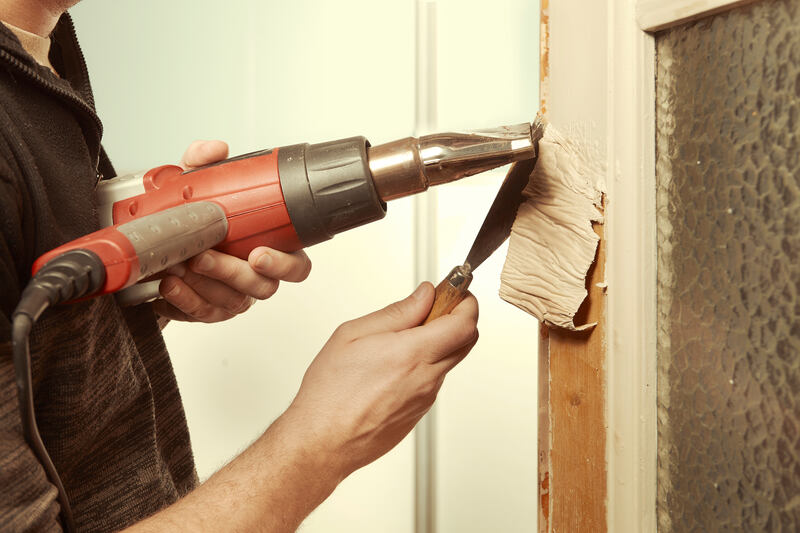How to use a heat gun to remove paint Leave a comment
A heat gun to remove paint is a game-changing tool for tackling stubborn coatings on wood, metal, and other surfaces. This device not only makes paint removal simpler but also enhances precision and control, making it a favorite among professionals and DIY enthusiasts. By delivering concentrated heat, it softens and loosens paint layers, allowing you to scrape them away effortlessly. A heat gun to remove paint is perfect for renovating furniture, restoring walls, and refinishing intricate details—all without relying on harsh chemicals or abrasive methods. Its versatility, eco-friendliness, and ability to achieve smooth, clean results make even the toughest paint removal tasks manageable and satisfying.
How Heat Guns Work for Paint Removal
When using a heat gun for paint removal, you unlock a powerful method that combines efficiency and precision. The hot air it generates targets layers of paint directly, causing them to bubble and blister for effortless scraping. By directing controlled heat where it’s needed, you loosen the paint without damaging the underlying surface, whether it’s wood, metal, or masonry. A heat gun eliminates the need for harsh chemicals, reducing environmental concerns and enhancing your project’s safety. With adjustable temperatures and specialized nozzles, you can tailor its performance to match the task, from delicate detailing to large surface areas. This versatility makes it an ideal choice for professionals and DIYers alike. You’ll appreciate how quickly it softens stubborn coatings, minimizing the effort and time spent on preparation. With the right tools in hand, paint removal becomes a streamlined process, giving you smoother results and a surface ready for a flawless finish.
Steps for Using a Heat Gun to Remove Paint
Prepare the working area
Begin by clearing the workspace to avoid clutter and potential fire hazards. Lay down drop cloths or tarps to collect debris and protect floors. Ensure proper ventilation by opening windows or working outside whenever possible.
Check the paint type
Identify whether the paint contains harmful materials like lead. If lead paint is present, always wear a lead-rated respirator and work in an open area. Lead vapors can pose significant health risks when exposed to high temperatures.
Choose the Correct Nozzle
Your heat gun’s performance depends on the type of nozzle you use. Selecting the right nozzle for your project ensures precise and safe heat application.
- Surface Nozzle: Ideal for large, flat surfaces, providing uniform heat distribution.
- Glass Protection Nozzle: Shields glass areas from direct heat, preventing cracking or damage.
- Reduction Nozzle: Focuses heat on smaller areas for detailed work.
- Reflector Nozzle: Directs heat around cylindrical surfaces (such as pipes or rounded edges).
The correct nozzle boosts efficiency and lowers the risk of damaging nearby materials.
Heat and scrape the paint
Set your heat gun to the right temperature. Then, increase it gradually to soften each layer effectively. Heat guns need 400°C (1000℉) to loosen paint. Hold the tool at a 45-degree angle. Keep it 2–3 inches from the surface. Move it steadily across a small section. Allow the paint to bubble evenly without scorching. As the layers loosen, use a putty knife or metal scraper to peel them away. This will reveal a clean, ready-to-work surface. Stubborn areas may need a second pass. But, with consistent heat, even the toughest spots yield quickly. The process saves time and keeps the material below intact. Each scrape saves energy and creates a perfect base for your next step. So, heat guns are a trusted choice for efficient paint removal.

Safety Precautions When Using a Heat Gun to Remove Paint
Heat guns reach temperatures that can ignite nearby materials or cause serious burns. To use them safely, follow these essential tips:
Minimize Fire Risks
Always keep a fire extinguisher nearby. Heat guns can blow hot air into cracks or behind painted surfaces. This can ignite dirt, dust, or unseen materials. Spraying the surface with water after use can help prevent smoldering fires.
Protect Yourself and the Environment
Wear a respirator face mask. This is vital with older paints that may release toxins when heated. Use protective gloves and goggles to guard against heat, fumes, and debris.
Avoid Material Damage
High heat can crack glass or scorch delicate materials. Use a glass protection nozzle around windows. Stick to low heat settings to avoid damage. Always test the heat gun on a small section before tackling the entire surface.
Alternative options for removing paint
If a heat gun to remove paint isn’t suitable for your project, consider using paint strippers or sanding instead, as they are also effective methods.
Paint strippers, in liquid or gel form, break down paint layers for easy removal. They’re especially useful for complex surfaces or areas where heat can’t be applied. The right formula can dissolve stubborn coatings. It will give you great results with little effort.
Sanding offers unmatched control. It lets you smooth surfaces while removing old paint. Power sanders can tackle large areas quickly. But hand sanding is best for detailed work or tight corners. Both methods are highly effective. But they require patience and care to avoid damaging the underlying material. A method suited to your needs will ensure high quality. It will also prep surfaces efficiently for a flawless finish.
FAQ
How long does it take to remove paint using a heat gun to remove paint?
The time required depends on the number of paint layers and the surface area. A typical section takes minutes once the paint begins to blister.
Can a heat gun remove varnish?
Yes, varnish is easier to remove than paint due to its thinner consistency. Heat guns soften varnish quickly for easy scraping.
Why isn’t my heat gun removing paint?
If stubborn spots persist, avoid overheating the area. Adjust the temperature setting and try again. Sanding may be needed for tough areas.
What do professionals use to strip paint?
Pros often use heat guns with strippers or sodium hydroxide on carved surfaces. This ensures thorough removal without damaging intricate designs.
Can I repaint without removing all old paint?
You don’t need to remove every layer. However, you should strip loose or flaking paint for better adhesion.
Can a hairdryer strip paint?
Hairdryers lack the high temperatures needed for effective paint removal. Use heat guns specifically designed for this purpose.
Key Benefits of Heat Guns for Paint Removal
- Efficiency: Removes paint faster than sanding or chemical methods.
- Cost-effectiveness: eliminates the need for repeated purchases of chemicals or sandpaper.
- Portability: Corded and cordless options allow flexibility in tight or remote spaces.
Enhancing Results with Heat Guns
Maximize the performance of your heat gun by pairing it with the right accessories. Use specialized nozzles, protective gear, and proper scrapers. They ensure better results and reduce risks.
With these tips, you can confidently tackle paint removal projects. You will know your tools and techniques are up to the task. Heat guns are a powerful way to strip paint from wood and metal.



